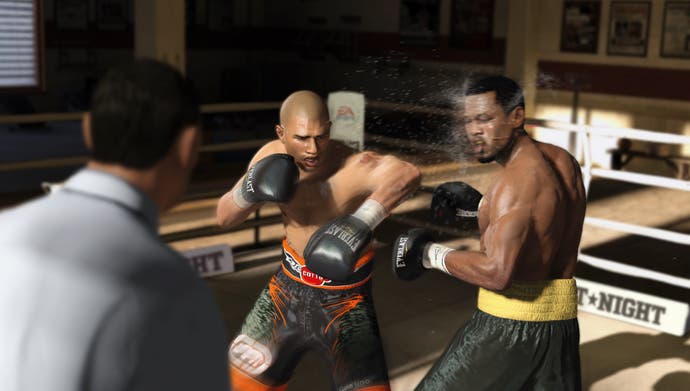Fight Night Champion
Handbags.
Society has a name for people like me: a button-basher. All my life I've been judged because my fighting game tactic is to furiously mash anything brightly coloured while pressing jump at the same time. When I lose, people shake their heads in disbelief at how pathetic I am. When I win, I have my head slammed against coffee tables.
I love the Fight Night series - read into that what you will. Some would argue that this is because, at a basic level, thoughtless tongue-between-teeth stick-twiddling can better disguised in Fight Night.
I would argue, however (and if you're a Street Fighter-type then feel free to hurl magic Hadouken-things at me in the comments thread), that the physical and directional movement of throwing punches with the analogue stick speaks directly to my brain in the way that kicks and punches hidden behind buttons never could.
I love the analogue flow of the punches and the damage they do in Fight Night, as opposed to the set, strict and digital health reductions of the attacks that connect in your Mortal Kaliburs and Virtua Tekkens.

I love the drama and the physical drain of each round, and I REALLY like it when you hit Lennox Lewis hard in the face and it goes all wobbly and starts spouting blood. And, having played EA's latest, I can underline that this is something Fight Night Champion is rather good at.
"Now we're a 16+ game we're able to do stuff with damage, so that's with cuts and with blood," explains Fight Night Champion producer Mike Mahar, having witnessed my clumsy thumbs starting to blur during an over-enthusiastic bout of stick-twiddling and a predictably messy conclusion.
"It's now 100 per cent realistic. Boxing at its best, in my opinion, can be pretty gruesome. We simply couldn't do that in Fight Night Round 4 so we toned it down, but now we're free to do what we want.
"The results are pretty cool: you'll get huge contusions on a guy's eye, eyes swollen completely over, big cuts on the nose, broken noses, blood on your chest, on your trunks, on your opponent's chest, on the mat..."
Charming stuff. That's not all though – Fight Night Champion seems intent on dispensing with traits that are more akin to videogame convention than real-life face-hitting. Needless screen furniture has been further pruned down, and the developers have entirely given up on any sort of silly 'wax on, wax off' inter-round mop-ups or 'Use Ice Bag on... Stamina!' mini-games.

How much you're healed and the stamina you regain is purely based on the punches you've thrown and the punches you've taken – just as it would if you'd gone a few rounds with a celebrity rapist in the real world.
It's also clear that the physics-based gameplay introduced in Fight Night Round 4 has been raised up a few notches – arms get more tangled, dodged punches make their way further behind your opponent's head. As a result the feeling of a more accurate, if potentially less free-flowing, simulation is secured.
This is aided and abetted by the most radical change from the previous Fight Night, a system stamped by the EA marketing machine as Full Spectrum Punch Control.
"In Fight Night Round 4 sometimes players would try to throw a hook, and get an uppercut. Or they'd try to throw an uppercut, and get a hook," says Mehar, miming the game's previous 'And directional pull and rotational... Flick!' punch system.
"The controls were pretty nuanced, and in the heat of battle when people went crazy on the controller it sometimes threw something out inaccurately. We've simplified the controls – you just have to flick out or down to get a hook and an uppercut respectively. If you don't flick perfectly down to get the quintessential straight-up-the-middle uppercut, and you're on an angle, you'll get a punch that reflects that."








